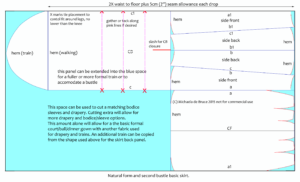http://www.arrayedindreams.com/tutorials-guides-and-articles/sewingpatterning/victorian-skirt-cutting-without-markings/
A large sample:
Materials and tools needed:
150cmwide (60″) cotton twill- approximately 3yards or just shy of 3m or more
115cm (45″) wide rayon crepe- approx 4 1/2 yards or just shy of 4m or more
long glass headed quilting pins (any pills but these are the easiest for this yardage)
shears or scissors (able to cut through two layers of fabric at least)
tape measure (optional)
Cutting 60″ fabric
Start with the fabric laid out folded in half, selvage to selvage
If you prefer an intuitive method start by holding the fabric to your waist and let it hand to floor unimpeeded and mark the hem- add a comfortable seam allowance to both waist and hem.
If you prefer use a tape measure to mark the length you desire for the side gores. This will be the length from where the waist sits, over the hip and down the side. Include shoe height plus an inch or two at hem and waist depending on your comfort. There are many ways to hem a skirt that is too short or too long.
I used 115cm (45″.)
Cats make excellent weights until they decide to play.
Cut across the fabric through both layers.
Next mark the width of the upper portion of the panels on opposite corners of the fabric (I place one at upper right along the cut across the fabric, and one at lower left ditto.) Then fold the fabric from mark to mark, making sure to keep all layers smooth and aligned.

I used 8″ or 20cm as I will be added pleats at the waist of these panels.
This is to go with the pattern layout guide 🙂
http://www.arrayedindreams.com/tutorials-guides-and-articles/sewingpatterning/late-historic-skirt-guides/
(Another large selection)
Pattern A:
Regency (1810s): waist; flat in front panel, lightly pleated/eased at side panels, gathered or pleated at CB panel. Gore angles steep. Cut waist and hem curves after trying on. The deeper the dip at the CF waist the straighter the side seams will fall.
Romantic (1820s-30s): lower waist slightly for 1820s and add ease to CF and side gores. Lower waist further for 1830s and gather/pleat from CF through all side panels while directing CB panel gathers/pleats towards the back.
No pattern, straight widths:
Mid century (1840s-50s): waist; increasingly gathered all around evenly. Panels become straight with little or no shaping. Gauging is most common though pleats and reverse pleats can be found.
Pattern B: Heavily gored skirts:
First Bustle (early 1870s): waist is flat at CF panel, eased at side panels, gathered/pleated in CB panel.
Crinoline (1860s): widen tops of each skirt panel to allow for more ease at the front and sides, this will straighten the side gores somewhat. Allow for some ease towards the sides and front, or create inverse pleats at each seam.
End of century (1890s): narrow tops as much as possible and replace straight CB panel with a panel cut like the CF panel and either slashed for the CB closure or cut straight down the CB. Towards 1900 cut the diagonals in curves (this will create a narrow ellipse shaped scrap on each diagonal) to create a trumpet hem.
Pattern C: Natural Form
Natural form (late 1870s-early 1880s): waist; flat all around front and sides, narrow gathered section at the very centre back. Front can be cut as a complete tube, back gores cut in steep angles.
Second bustle (mid to late 1880s): cut the side gores wider in general with similar angles, this may mean cutting only two gores where there are four above and using the blue area for the other side gores. make note which sides have been cut.
I basically used the 1870s and 1890s pattern but with straighter diagnonals as this skirt is fairly straight up and down.
Oh I used my Phantom of the Opera wedding dress fabrics 🙂 I’ve actually started to tackle my wall of projects! It only took about.. 9 months to actually do this! I was supposed to take my step down as a chance to make stuff for me, but I mostly wound up spending the year recovering from the last eight! So, a delay is understandable!
Anyway so the lace is all back in a box of lace trimmings but now that I’ve put scissors to fabric I’ll be able to take it out and get it all sorted again. I have a ridiculous amount of vintage lace so I really wanted a good fabric foundation. And now I have.
the Australian wedding dresses had a crepey texture when I saw them in person so this is perfect 🙂 just have to iron it all a few times while handling.
And then, or at the same time, I’ll start work on.. THE SUNBURST GOWN!!!!!! I have to stop waiting for an event to wear it to and just make it. So that is what I’m doing 🙂







